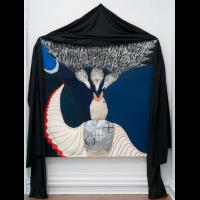I first felt the power of art when learning about the ancient world. The ancients could convey a complex, deep, and philosophical thought in one image, even in one shape like a circle (the One, unity). This idea that a circle could be more than just a “circle” stirred within me the idea that to look only at the surface was to miss the complex treasure buried underneath. I’ve taken this impetus and used it to create my thesis project, which is attempting to address some very deep and complex universal truths. I’m asking the viewer to look past the surface and dig into the past.
This project meant to find balance in what I want and what I can have. I wanted to do something a little dramatic and theatrical and I have always found ancient art to be the most captivating. I would like to posit that because so many were illiterate and images had to be used in order to communicate with each other that it was assumed every image, every color, every line, every measurement and ratio had a multi-faceted "meaning."
To me, sacred geometry and symbolism is not only beautiful but also profound. But does one need to know what they "mean" before they are "understood"? Ancients told each other what the symbols "meant." It was their language. Can it be ours too? In an age of logos, trademarks, and advertisements for material things, can the ancient symbols still hold their weight?
I like symbols; I think in pictures, and this picture came to me a long time ago. I had to figure out what it meant for me. I needed to find courage inside me, to try something risky, something that I knew in my gut I had to do, but couldn't exactly see it. I chose to have a square 6'x6' canvas and used the golden ratio as a factor in my composition. The numbers and shapes have been significant to humans since "the beginning." To the ancients, each number had its own “meaning”, its own personality. To you, 4 might be just a number; to others it’s the Earth, the start of multiplicity. I have put my faith, so to speak, in the hands of ancient thinking, using their ideas about balance, life and death, and acceptance of evil as necessity in order for us to know what true good is.
That other world isn't tangible, very few have traveled back and forth, but we have based so much on it. Could my artwork be an example of simulacra? Don't look this word up in the dictionary, read about it.
I needed to find out that what we "know" has to be programmed into us. I've chosen to program myself with some esoteric knowledge – why? Perhaps because I want to believe the world is more than Nike swooshes and Mac apples. Now we covet these symbols, what about tomorrow? Once there was a symbol found across the ancient worlds, a symbol of peace, universal movement, good luck, then one day a man twisted it and it became a symbol of evil and death.
My thesis project visually seems so simple, but when I take into account all of the subtle intricacies that I experienced in making this painting, I realize that there is much more than meets the eye. I do fully expect many to skim the surface, but I hope those who choose to dig deeper will find their efforts rewarded.




